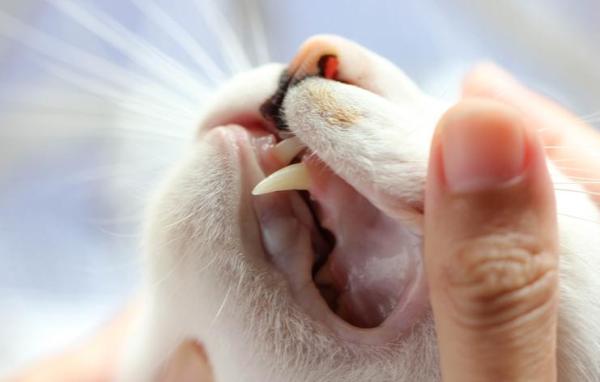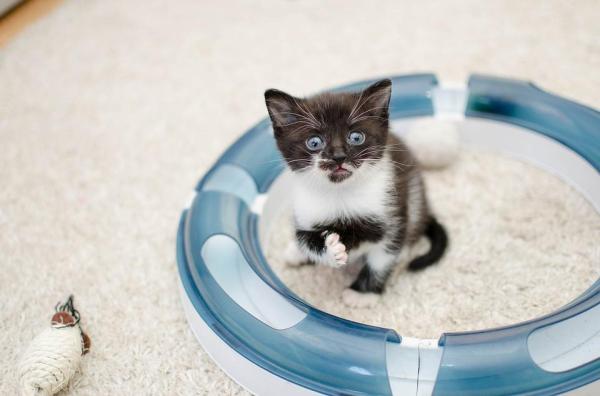Why Is My Cat Losing Teeth?



See files for Cats
If your cat is losing teeth, the first thing we need to know is whether they are a kitten or adult cat. When a kitten develops into an adult cat, they will go through many changes. As they reach maturity, they will develop a set of adult teeth, but will have to lose their milk teeth first. When an adult cat loses their teeth, there are no new teeth to replace them, something which can greatly affect their health and wellbeing. Any sign an adult cat is losing their teeth is a cause for concern. Various problems can resulting in feline tooth loss, including periodontal disease, infections or as a secondary result of an underlying health condition.
If you have observed a new gap in your cat's smile, you may want to discover why your cat is losing teeth. Fortunately, AnimalWised is here to help. Following the advice in this article you can improve their oral hygiene as well as troubleshoot for any possible health problems.
My kitten is losing teeth
Cats are born without teeth as their mouth and tongue are designed to suckle on their mother's teats for milk. During the weaning process, the little ones begin to start developing ‘milk teeth’ so they can graduate to solid food. This usually occurs from the third week of life onward. Since they do not have teeth, we need to feed newborn kittens on liquids if they are separated from their mother.
At kittens first set of teeth consists of 26 individual teeth, but they will only become visible around the 6th or 7th week. At this point, the teeth are small yet sharp, especially the canines or fangs. This means a bite from a kitten can still be quite painful.
At around 3 or 4 months of age, cats will start to experience the loss of their milk teeth. This is when the baby teeth give rise to their adult teeth creating the dental structure of an adult cat. This dentition consists of 30 individual adult teeth, thicker and more durable than the previous set. Their growth can cause a certain amount of discomfort in young cats as they grow through the gums.
During this transition of baby to adult teeth, your kitten may nibble on furniture, objects or whatever is lying around. This is the same as when toddlers are teething. Its purpose is to alleviate the discomfort caused by the teeth coming through. To avoid damage to your property or others in the home, it's best to have toys or teething products to help kittens when losing teeth. Additionally, it can be difficult to feed due to the pain, so you may want to add a little warm water to their food in case it is too hard to for them to break down.
We recommend you check your kitten's teeth daily during this process to avoid any improper growth which can lead to pain and infection. If you do detect any anomalies in this development, take your cat to the veterinarian so they can examine them and see if any particular action needs to be taken.
My adult cat is losing teeth
As stated above, an adult cat's dentition should be composed of 30 individual teeth. The powerful canines (the ones which look like fangs) stand out the most. As they are obligate carnivores, these are useful in the wild to tear flesh from their prey. The upper jaw should have 6 incisors, 2 canines (1 on each side), 6 premolars (3 on each side) and 2 molars (one at each end). In the bottom jaw is the same with the exception of 4 premolars instead of 6.
If you see your adult cat is losing teeth, you may wonder if it is normal. It is not uncommon for a cat to lose 1 or 2 permanent teeth during their adult life. However, tooth loss for adult cats in general is a sign of imbalance in their body. Many pet owners neglect the oral hygiene of their cats. This can lead to the accumulation of tartar and can make it difficult to tell whether they have lost a tooth.

Reasons why my cat is losing teeth
If your kitten is losing teeth due to natural tooth loss, all we can do is support them through this time. We can give them softer food and even provide chew toys for them to relieve the frustration of the process. If an adult cat is losing teeth, we need to discover the reason for it. The most common causes of tooth loss in adult cats is:
- Periodontal disease: feline periodontal disease is a progressive condition which is the main cause of tooth loss in cats[1]. When remnants of food accumulate in the cat's mouth, it builds up bacterial plaque. In turn, this leads to hardened tartar which starts to push at the gumline. The result is tooth decay and eventual tooth loss.
- Gingivostomatitis: an infectious disease which can result in the inflammation of the gums (gingiva). It is not well understood, but it may be related to other infections or a poor immune system. The main symptoms are the cat having red and swollen gums, but it can eventually lead to tooth loss.
- Injury: another important reason for tooth loss in cats is injury. Since cats use their mouth to explore and interact with their environment, it is common for them to bite things they shouldn't. Unlike humans, felines do not have bite surfaces on their permanent teeth which allow chewing[2]. For a wild cat, this is not usually a problem as their diet consists of almost solely raw meat. Its powerful molars act like scissors which slice the food and negate the need to chew. For domestic cats, they can bite or eat things which they shouldn't. This is a common reason why a cat loses a fang since these teeth stick out more than the others. Collisions, falls and other injuries can also result in a cat losing teeth.
- Diet: apart from eating hard objects, a poor diet can result in a cat losing their teeth. Cats need various nutrients from their diet, many of which they cannot otherwise synthesize. Calcium is an important nutrient which maintains normal tissue function in cats[3]. If they do not eat properly, they will not get the nutrients they need and their teeth can fall out as a result. Since they are obligate carnivores, we cannot easily feed cats a vegan or vegetarian diet.
- Underlying health problem: if a cat has an underlying systemic health problem it can affect their teeth. Autoimmune diseases and other immune-mediated diseases can mean the cat cannot properly defend against various pathogens and infections are more likely. This can harm their organism and result in poor coat quality, tissue damage and even tooth loss. An example can be found in feline AIDS, otherwise known as feline immunodeficiency virus.
What to do when my cat is losing teeth
It is essential to periodically check the teeth, gums, tongue and mouth cavity of your cat. When you do this, you need to look out for any wound, change of color, change of texture, excessive drooling, unpleasant aroma (in the form of bad breath) or pus. If you do notice the health of your cat's mouth is low or there is something specifically wrong, a vet check-up will be necessary.
Domestic cats generally only eat dry kibble and wet food. This is a healthy diet for cats which avoids the possibility of developing many of the pathologies related to the consumption of raw meat (such as toxoplasmosis). However, it can promote poor oral hygiene due to the accumulation of tartar caused by food waste.
When we do not provide adequate oral hygiene for our cats, the excessive accumulation of tartar on their teeth and gums can lead to problems. These include dental injuries (such a broken or loose teeth) and some related diseases such as gingivitis in cats and periodontal disease. If we don't deal with these dental problems swiftly, it can lead to the loss of teeth, possible infection and digestion problems.
This lack of good oral hygiene can also lead to the loss of teeth in other ways. The weakened teeth are more likely to come loose or be knocked out if they have a fall or even get into a fight. Even healthy teeth can become damaged in this way. If they are snagged or are hit against something hard, it can cause the loss or damage of teeth.
For all of these reasons, we need to take the cat to a veterinarian as soon we see symptoms such as a cat's teeth falling out. If there is a specific infection, the vet can administer antibiotics or provide supportive therapies to help the cat overcome the pathogen. If they have an immune-mediated disease, they may change their diet or give supportive medications to help manage symptoms.

How to prevent the loss of teeth in adult cats
The best way to prevent tooth loss in cats is to ensure they have good overall oral hygiene. This won't just protect against tartar, but will help your cat stay healthy in general and help fight infection. Part of this job is to keep your cat's teeth brushed.
Another important consideration in keeping your cat's teeth healthy is to consider their diet. Some veterinarians may suggest a raw food diet (known as BARF) for your cat. However, making sure your cat has all the nutrients you need doesn't necessarily mean a raw food diet. Knowing what is the best diet for your cat is more about assessing their overall nutritional needs which can just as easily be achieved with commercially available feed. Also, your cat's own tastes may have something to say about what they will want to eat.

This article is purely informative. AnimalWised does not have the authority to prescribe any veterinary treatment or create a diagnosis. We invite you to take your pet to the veterinarian if they are suffering from any condition or pain.
If you want to read similar articles to Why Is My Cat Losing Teeth?, we recommend you visit our Other health problems category.
1. Perry, R., & Tutt, C. (2015). Periodontal disease in cats: back to basics--with an eye on the future. Journal of feline medicine and surgery, 17(1), 45–65.
https://doi.org/10.1177/1098612X14560099
2. Serra, C. M., & Manns, A. E. (2013). Bite force measurements with hard and soft bite surfaces. Journal of oral rehabilitation, 40(8), 563–568.
https://doi.org/10.1111/joor.12068
3. Stockman, J., Villaverde, C., & Corbee, R. J. (2021). Calcium, Phosphorus, and Vitamin D in Dogs and Cats: Beyond the Bones. The Veterinary clinics of North America. Small animal practice, 51(3), 623–634. https://doi.org/10.1016/j.cvsm.2021.01.003







